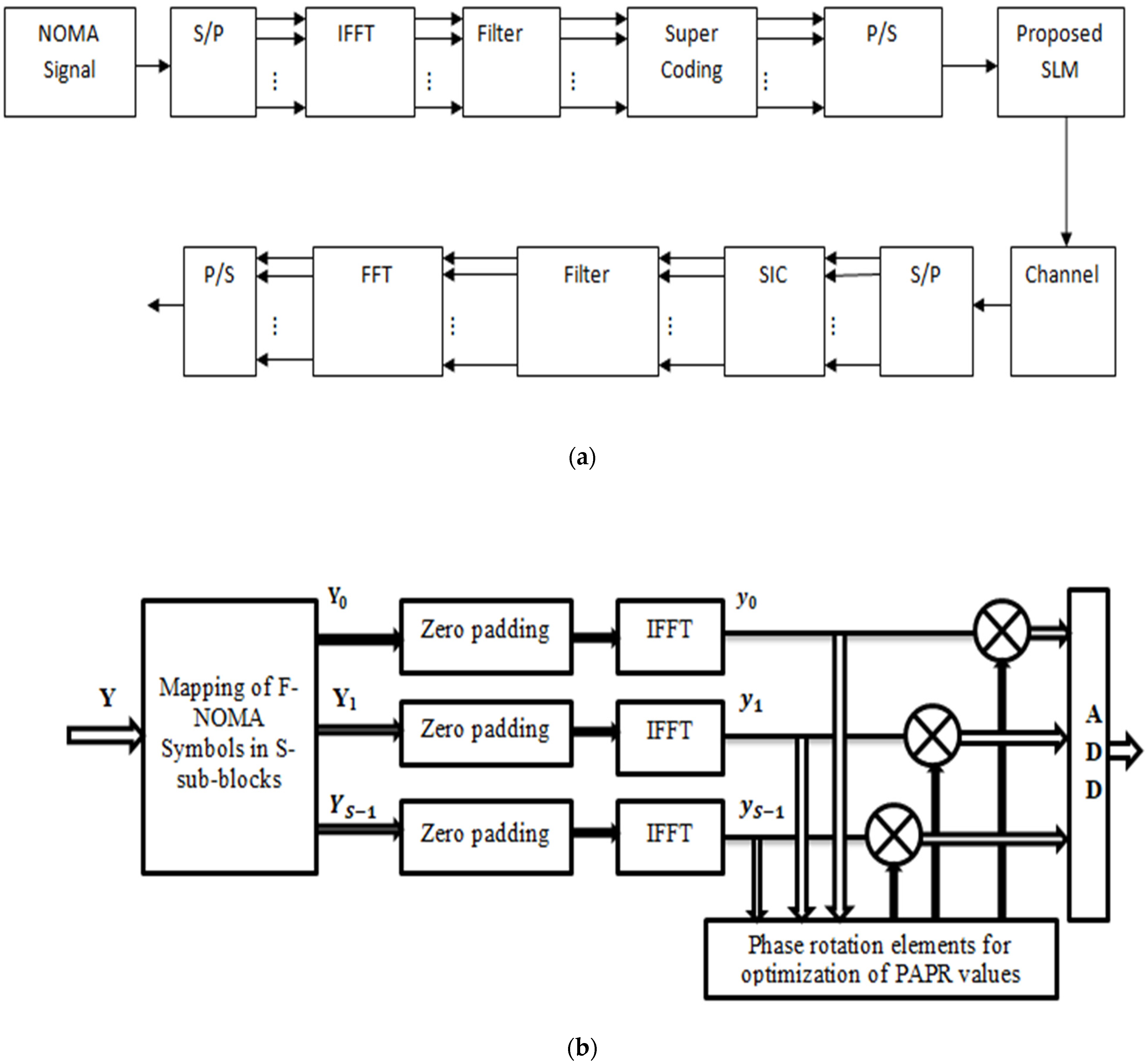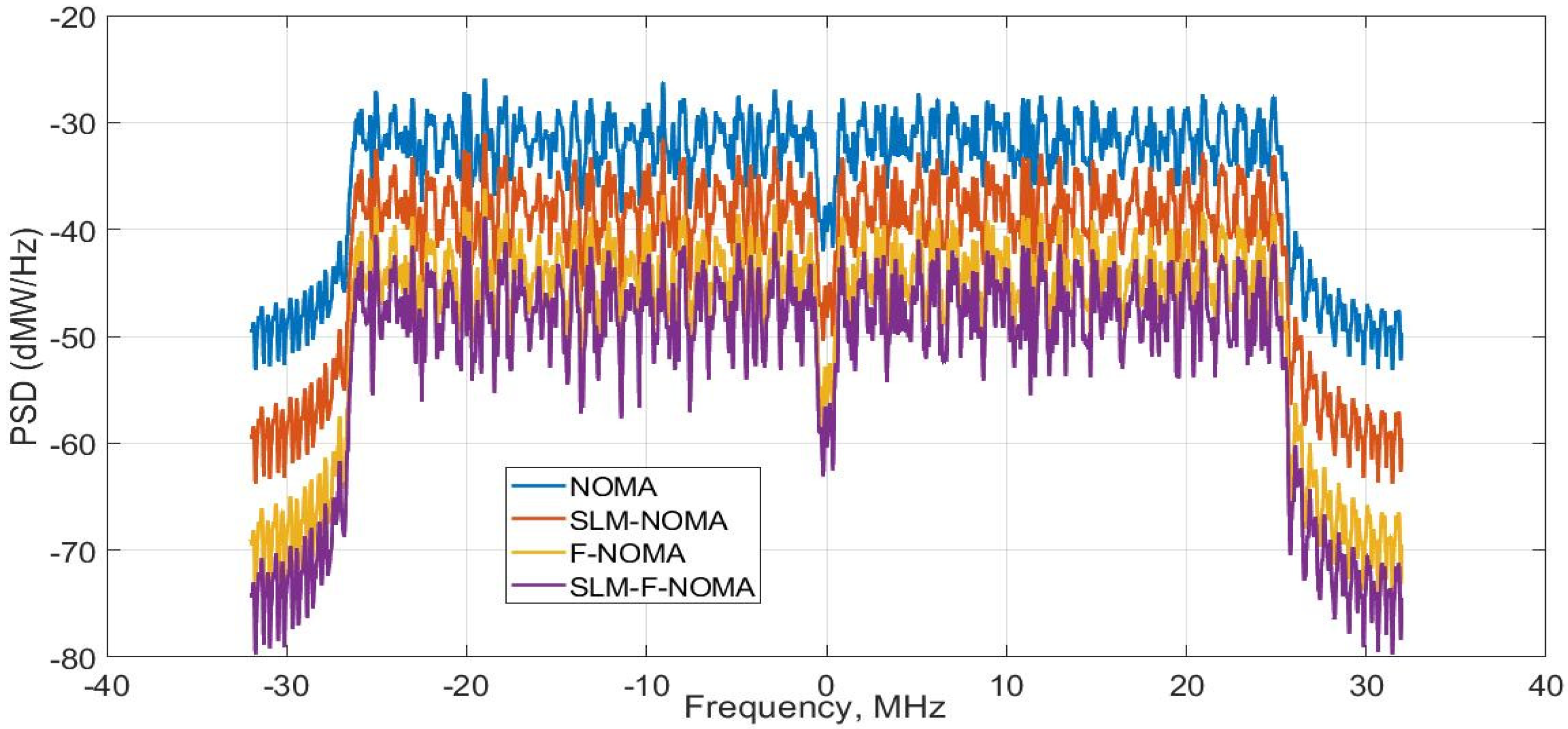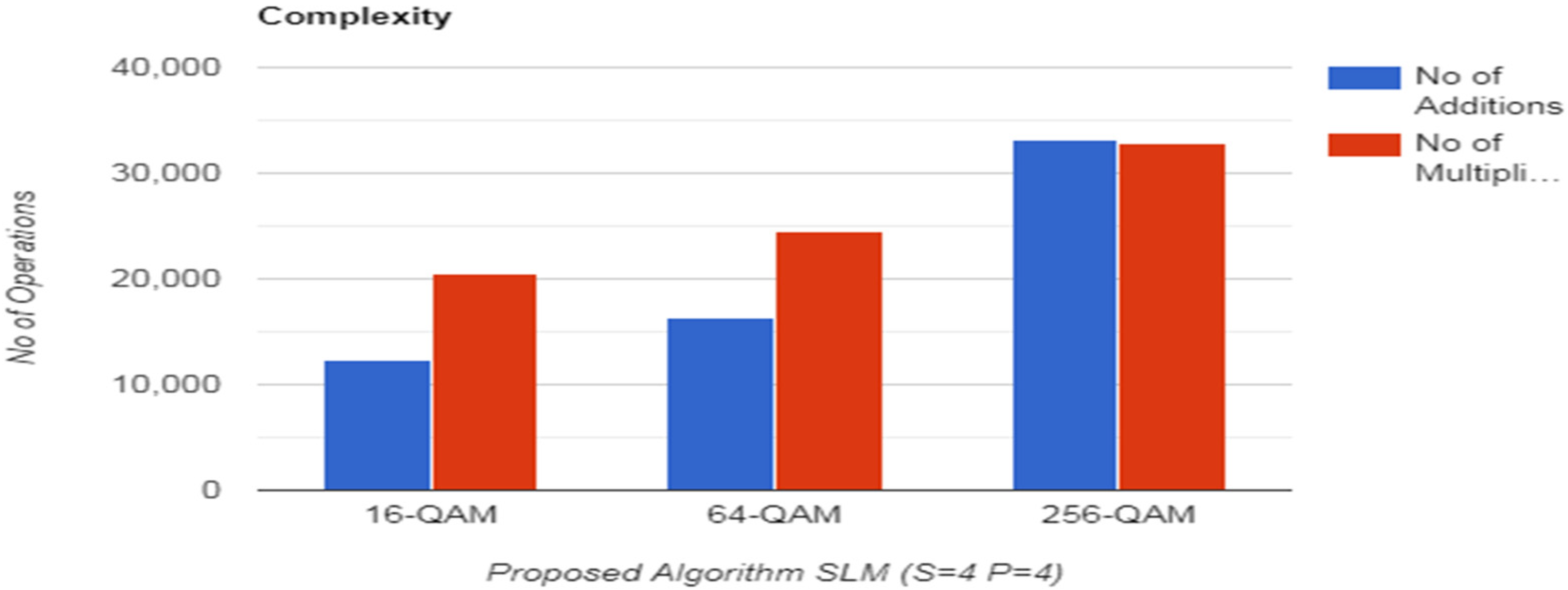Reducing PAPR with Low Complexity Filtered NOMA Using Novel Algorithm
Abstract
:1. Introduction
- The suggested scheme has ominously lowered the PAPR with low complexity.
- We have analyzed the PAPR, BER, Power Spectral Density (PSD), Power Performance, and Intricacy of the proposed algorithm for a high number of QAM schemes.
2. System Model
3. Simulation Results
3.1. PAPR Performance of 16-QAM
3.2. BER Analysis
3.3. Power Spectral Density
3.4. Complexity
3.5. Power Saving Performance
4. Discussion and Conclusions
Author Contributions
Funding
Conflicts of Interest
References
- Khan, M.; Rao, K.; Amuru, S.; Kuchi, K. Low PAPR reference signal transceiver design for 3GPP 5G NR uplink. J. Wirel. Commun. Netw. 2020, 2020, 182. [Google Scholar] [CrossRef]
- Lavanya, P.; Satyanarayana, P.; Mohatram, M. Evaluation of PAPR Reduction Ability of 5g Inspired Waveform Candidates. Int. J. Adv. Res. Eng. Technol. (IJARET) 2020, 11, 1469–1483. [Google Scholar]
- Ramakrishnan, B.; Kumar, A.; Chakravarty, S.; Masud, M.; Baz, M. Analysis of FBMC Waveform for 5G Network Based Smart Hospitals. Appl. Sci. 2021, 11, 8895. [Google Scholar] [CrossRef]
- Hussain, S.; Louet, Y. Peak to Average Power Ratio Analysis of Multi-carrier and Multi-standard Signals in Software Radio Context. In Proceedings of the 2008 3rd International Conference on Information and Communication Technologies: From Theory to Applications, Damascus, Syria, 7–11 April 2008; pp. 1–5. [Google Scholar] [CrossRef]
- Abdalla, H.F.; Hassan, E.S.; Dessouky, M.I. Peak to average power ratio (PAPR) reduction in filter bank multicarrier (FBMC) and orthogonal frequency division multicarrier (OFDM) based visible light communication systems. J. Opt. Commun. 2020, 2020, 000010151520200085. [Google Scholar] [CrossRef]
- Kumar, A.; Chakravarty, S.; Suganya, S.; Masud, M.; Aljahdali, S. Papr reduction using advanced partial transmission scheme for 5g waveforms. Comput. Syst. Sci. Eng. 2022, 42, 483–492. [Google Scholar] [CrossRef]
- Kumar, A.; Albreem, M.A.; Alsharif, M.H.; Jahid, A.; Uthansakul, P.; Nebhen, J. An efficient genetic hybrid papr technique for 5g waveforms. Comput. Mater. Contin. 2021, 67, 3283–3292. [Google Scholar] [CrossRef]
- Al-Jawhar, Y.A.; Ramli, K.N.; Taher, M.A.; Shah, N.S.M.; Mostafa, S.A.; Khalaf, B.A. Improving PAPR performance of filtered OFDM for 5G communications using PTS. ETRI J. 2021, 43, 209–220. [Google Scholar] [CrossRef]
- Al-Jawhar, Y.A.; Ramli, K.N.; Mustapha, A.; Mostafa, S.A.; Shah, N.S.M.; Taher, M.A. Reducing PAPR With Low Complexity for 4G and 5G Waveform Designs. IEEE Access 2019, 7, 97673–97688. [Google Scholar] [CrossRef]
- Kaur, S.; Kansal, L.; Gaba, G.S.; Alraddady, F.; Arora, S.K. Impact of Hybrid PAPR Reduction Techniques on FBMC for 5G Applications. Int. J. Smart Sens. Intell. Syst. 2020, 13, 1–10. [Google Scholar] [CrossRef]
- Kumar, A.; Albreem, M.A.; Gupta, M.; Alsharif, M.H.; Kim, S. Future 5G Network Based Smart Hospitals: Hybrid Detection Technique for Latency Improvement. IEEE Access 2020, 8, 153240–153249. [Google Scholar] [CrossRef]
- Kumar, A. A Novel Hybrid PAPR Reduction Technique for NOMA and FBMC System and its Impact in Power Amplifiers. IETE J. Res. 2019. [Google Scholar] [CrossRef]
- Chintala, V.D.; Sundru, A. PAPR Reduction in Universal Filtered Multicarrier Systems with Companding Transform. In Proceedings of the 2020 Third International Conference on Advances in Electronics, Computers and Communications (ICAECC), Bangalore, India, 11–12 December 2020; pp. 1–4. [Google Scholar] [CrossRef]
- Noorazlina, M.S.; Sulong, S.M.; Said, M.S.M.; Ahmad, I.; Idris, A. Design of MIMO F-OFDM System Model for PAPR Reduction in the Growth of 5G Network. J. Phys. Conf. Ser. 2021, 1793, 012067. [Google Scholar] [CrossRef]
- Mhatrea, K.; Khot, U.P. fficient Selective Mapping PAPR Reduction Technique. Procedia Comput. Sci. 2015, 45, 620–627. [Google Scholar] [CrossRef] [Green Version]
- Tani, K.; Medjahdi, Y.; Shaiek, H.; Zayani, R.; Roviras, D. PAPR reduction of post-OFDM waveforms contenders for 5G & Beyond using SLM and TR algorithms. In Proceedings of the 2018 25th International Conference on Telecommunications (ICT), Saint-Malo, France, 26–28 June 2018; pp. 104–109. [Google Scholar] [CrossRef]
- Kumar, A.; Bhargav, A.; Karthikeyan, A.; Rajagopal, K.; Srinivasan, A.K.; Tsegay, A.N. Low Computational Artificial Intelligence Genetic Algorithm Assisted SLM PAPR Reduction Technique for Upcoming 5G Based Smart Hospital. In Metaheuristic and Evolutionary Computation: Algorithms and Applications. Studies in Computational Intelligence; Malik, H., Iqbal, A., Joshi, P., Agrawal, S., Bakhsh, F.I., Eds.; Springer: Singapore, 2020; Volume 916. [Google Scholar] [CrossRef]
- Al-Rayif, M.I.; Seleem, H.E.; Ragheb, A.M.; Alshebeili, S.A. PAPR Reduction in UFMC for 5G Cellular Systems. Electronics 2020, 9, 1404. [Google Scholar] [CrossRef]
- Ayeswarya, R.; Prabha, N.A. Fractional Wavelet Transform based PAPR Reduction Schemes in Multicarrier Modulation System. IETE J. Res. 2019, 68, 732–742. [Google Scholar] [CrossRef]
- Carcangiu, S.; Fanni, A.; Montisci, A. A Closed Form Selected Mapping Algorithm for PAPR Reduction in OFDM Multicarrier Transmission. Energies 2022, 15, 1938. [Google Scholar] [CrossRef]
- Timande, B.D.; Nigam, M.K. PAPR Reduction an effective approach for next frontier MIMO-OFDM systems. J. Eng. Res. 2021. [Google Scholar] [CrossRef]









| References | PAPR Reduction (dB) at 10−3 | Remarks |
|---|---|---|
| [14] | 10 | A Block Coding (BC) scheme is used to reduce the PAPR of the F-OFDM. However, the complexity and applicability of the BC for advanced waveforms is not discussed in the presented work. |
| [15] | 7 | The authors introduced a SLM for the OFDM structure. The increased number of subcarriers affects the amplifier efficacy. High BER is seen as one of the drawbacks of the suggested work. |
| [16] | 7.2 | The authors proposed a SLM for 5G waveforms and OFDM. When applied to OFDM, the proposed algorithms performed well, but the computation requirements for 5G were high. |
| [17] | 6.8 | The genetic algorithm-based PAPR schemes were introduced for advanced radio structure. The PAPR reduction is obtained at high BER. |
| [18] | The article discussed the role of SLM in reducing the bandwidth leakage issue for the Universal Filter Multi Carrier (UFMC) waveform. The PAPR and BER analysis are not performed in the presented article. | |
| [19] | 7.9 | The authors studied the throughput and amplifier performance of the UFMC structure. A significant reduction in power is obtained with high throughput. However, the computational factor is not discussed. |
| Proposed Work | 2.4, 4.9 and 5.2 | A novel SLM-based F-NOMA is implemented, and significant power savings are obtained despite the low computation resource requirements. |
| S.No. | Parameters |
|---|---|
| 1 | Scheme: 16-QAM, 64-QAM and 256-QAM |
| 2 | Sub-block (S) = 2, 4 |
| 3 | Sub-carrier (N) = 64 |
| 4 |
| S.NO. | Proposed Algorithm | Transmission Schemes | No of Additions | No of Multiplications |
|---|---|---|---|---|
| 1 | SLM (S = 4 p = 4) | 16-QAM | 12,288 | 20,480 |
| 2 | SLM (S = 4 p = 4) | 64-QAM | 16,384 | 24,576 |
| 3 | SLM (S = 4 p = 4) | 256-QAM | 33,088 | 32,768 |
| S.No | Proposed PAPR Algorithms | Original PAPR for 16-QAM (dB) | PAPR Reduction (dB) | Power Saving *100 (%) [16] |
|---|---|---|---|---|
| 1 | SLM (S = 4 p = 4) | 8.2 | 2.4 | 70.70% |
| 2 | SLM (S = 4 p = 2) | 8.2 | 4 | 51.21% |
| 3 | SLM (S = 2 p = 4) | 8.2 | 4.8 | 41.46% |
| 4 | SLM (S = 2 p = 2) | 8.2 | 6.6 | 19.51% |
| S.No | Proposed PAPR Algorithms | Original PAPR for 64-QAM (dB) | PAPR Reduction (dB) | Power Saving *100 (%) |
|---|---|---|---|---|
| 1 | SLM (S = 4 p = 4) | 9.5 | 5.2 | 45.26% |
| 2 | SLM (S = 4 p = 2) | 9.5 | 5.9 | 37.89% |
| 3 | SLM (S = 2 p = 4) | 9.5 | 7 | 26.32% |
| 4 | SLM (S = 2 p = 2) | 9.5 | 8.2 | 13.68% |
| S.No | Proposed PAPR Algorithms | Original PAPR for 256-QAM (dB) | PAPR Reduction (dB) | Power Saving *100 (%) |
|---|---|---|---|---|
| 1 | SLM (S = 4 p = 4) | 10 | 4.9 | 51% |
| 2 | SLM (S = 4 p = 2) | 10 | 5.8 | 42% |
| 3 | SLM (S = 2 p = 4) | 10 | 6.7 | 33% |
| 4 | SLM (S = 2 p = 2) | 10 | 9 | 10% |
Publisher’s Note: MDPI stays neutral with regard to jurisdictional claims in published maps and institutional affiliations. |
© 2022 by the authors. Licensee MDPI, Basel, Switzerland. This article is an open access article distributed under the terms and conditions of the Creative Commons Attribution (CC BY) license (https://creativecommons.org/licenses/by/4.0/).
Share and Cite
Kumar, A.; Rajagopal, K.; Gugapriya, G.; Sharma, H.; Gour, N.; Masud, M.; AlZain, M.A.; Alajmani, S.H. Reducing PAPR with Low Complexity Filtered NOMA Using Novel Algorithm. Sustainability 2022, 14, 9631. https://doi.org/10.3390/su14159631
Kumar A, Rajagopal K, Gugapriya G, Sharma H, Gour N, Masud M, AlZain MA, Alajmani SH. Reducing PAPR with Low Complexity Filtered NOMA Using Novel Algorithm. Sustainability. 2022; 14(15):9631. https://doi.org/10.3390/su14159631
Chicago/Turabian StyleKumar, Arun, Karthikeyan Rajagopal, G. Gugapriya, Himanshu Sharma, Nidhi Gour, Mehedi Masud, Mohammed A. AlZain, and Samah H. Alajmani. 2022. "Reducing PAPR with Low Complexity Filtered NOMA Using Novel Algorithm" Sustainability 14, no. 15: 9631. https://doi.org/10.3390/su14159631
APA StyleKumar, A., Rajagopal, K., Gugapriya, G., Sharma, H., Gour, N., Masud, M., AlZain, M. A., & Alajmani, S. H. (2022). Reducing PAPR with Low Complexity Filtered NOMA Using Novel Algorithm. Sustainability, 14(15), 9631. https://doi.org/10.3390/su14159631







